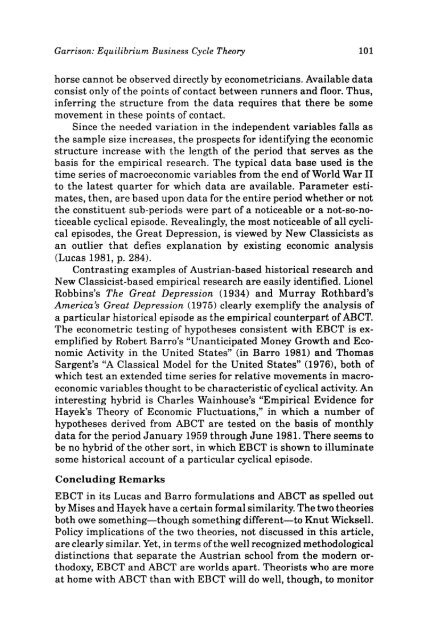Review of Austrian Economics - The Ludwig von Mises Institute
Review of Austrian Economics - The Ludwig von Mises Institute
Review of Austrian Economics - The Ludwig von Mises Institute
Create successful ePaper yourself
Turn your PDF publications into a flip-book with our unique Google optimized e-Paper software.
Garrison: Equilibrium Business Cycle <strong>The</strong>ory 101<br />
horse cannot be observed directly by econometricians. Available data<br />
consist only <strong>of</strong> the points <strong>of</strong> contact between runners and floor. Thus,<br />
inferring the structure from the data requires that there be some<br />
movement in these points <strong>of</strong> contact.<br />
Since the needed variation in the independent variables falls as<br />
the sample size increases, the prospects for identifying the economic<br />
structure increase with the length <strong>of</strong> the period that serves as the<br />
basis for the empirical research. <strong>The</strong> typical data base used is the<br />
time series <strong>of</strong> macroeconomic variables from the end <strong>of</strong> World War II<br />
to the latest quarter for which data are available. Parameter estimates,<br />
then, are based upon data for the entire period whether or not<br />
the constituent sub-periods were part <strong>of</strong> a noticeable or a not-so-noticeable<br />
cyclical episode. Revealingly, the most noticeable <strong>of</strong> all cyclical<br />
episodes, the Great Depression, is viewed by New Classicists as<br />
an outlier that defies explanation by existing economic analysis<br />
(Lucas 1981, p. 284).<br />
Contrasting examples <strong>of</strong> <strong>Austrian</strong>-based historical research and<br />
New Classicist-based empirical research are easily identified. Lionel<br />
Robbins's <strong>The</strong> Great Depression (1934) and Murray Rothbard's<br />
America's Great Depression (1975) clearly exemplify the analysis <strong>of</strong><br />
a particular historical episode as the empirical counterpart <strong>of</strong> ABCT.<br />
<strong>The</strong> econometric testing <strong>of</strong> hypotheses consistent with EBCT is exemplified<br />
by Robert Barro's "Unanticipated Money Growth and Economic<br />
Activity in the United States" (in Barro 1981) and Thomas<br />
Sargent's "A Classical Model for the United States" (1976), both <strong>of</strong><br />
which test an extended time series for relative movements in macroeconomic<br />
variables thought to be characteristic <strong>of</strong> cyclical activity. An<br />
interesting hybrid is Charles Wainhouse's "Empirical Evidence for<br />
Hayek's <strong>The</strong>ory <strong>of</strong> Economic Fluctuations," in which a number <strong>of</strong><br />
hypotheses derived from ABCT are tested on the basis <strong>of</strong> monthly<br />
data for the period January 1959 through June 1981. <strong>The</strong>re seems to<br />
be no hybrid <strong>of</strong> the other sort, in which EBCT is shown to illuminate<br />
some historical account <strong>of</strong> a particular cyclical episode.<br />
Concluding Remarks<br />
EBCT in its Lucas and Barro formulations and ABCT as spelled out<br />
by <strong>Mises</strong> and Hayek have a certain formal similarity. <strong>The</strong> two theories<br />
both owe something—though something different—to Knut Wicksell.<br />
Policy implications <strong>of</strong> the two theories, not discussed in this article,<br />
are clearly similar. Yet, in terms <strong>of</strong> the well recognized methodological<br />
distinctions that separate the <strong>Austrian</strong> school from the modern orthodoxy,<br />
EBCT and ABCT are worlds apart. <strong>The</strong>orists who are more<br />
at home with ABCT than with EBCT will do well, though, to monitor

















